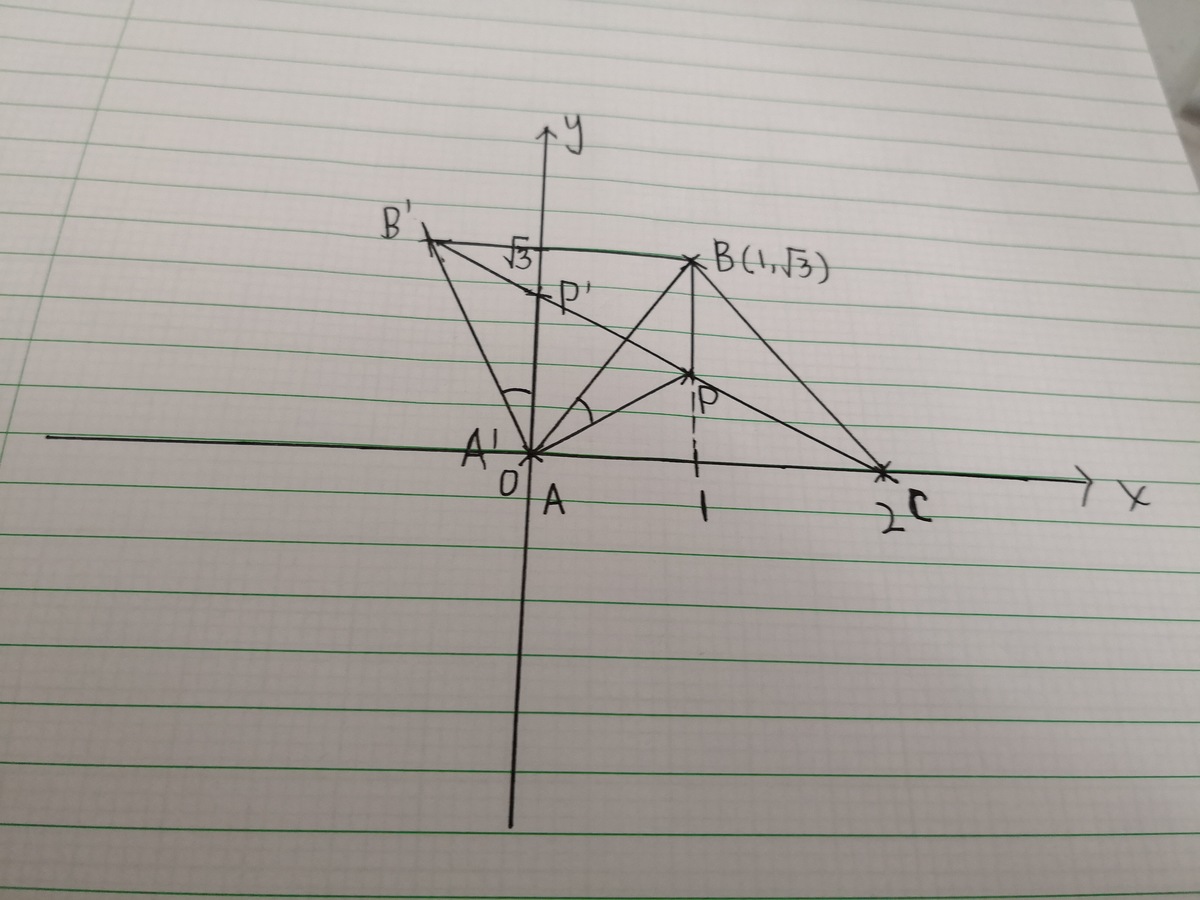Geometrically Algebraic
Given a function f ( x , y ) for real values x , y , find the minimum value of f ( x , y ) such that
f ( x , y ) = ( x − 2 ) 2 + y 2 + x 2 + y 2 + ( x − 1 ) 2 + ( y − 3 ) 2
If the answer can be written as a b , such that a , b are positive integers and b does not contain square factors. Find a + b .
Bonus: Try generalizing this problem.
This is part of the set Fun With Problem-Solving .
The answer is 5.
This section requires Javascript.
You are seeing this because something didn't load right. We suggest you, (a) try
refreshing the page, (b) enabling javascript if it is disabled on your browser and,
finally, (c)
loading the
non-javascript version of this page
. We're sorry about the hassle.
2 solutions

Let A ( 0 , 0 ) , B ( 1 , 3 ) , C ( 2 , 0 ) , P ( x , y )
f ( x , y ) = ( x − 2 ) 2 + y 2 + x 2 + y 2 + ( x − 1 ) 2 + ( y − 3 ) 2
∣ P A ∣ + ∣ P B ∣ + ∣ P C ∣ = ( x − 2 ) 2 + y 2 + x 2 + y 2 + ( x − 1 ) 2 + ( y − 3 ) 2
So, f ( x , y ) = ( x − 2 ) 2 + y 2 + x 2 + y 2 + ( x − 1 ) 2 + ( y − 3 ) 2
Now, rotate Δ P A B in 6 0 ∘ anticlockwise about point A and construct the triangle Δ B B ′ A .
Let the image of point A be A ′ , the image of point B be B ′ , the image of point P be P ′
Δ P A B ≅ Δ P ′ A ′ B ′
∠ P ′ A ′ B ′ = ∠ P A B
Let ∠ P ′ A ′ B ′ = ∠ P A B = θ
∠ P ′ A ′ B = 6 0 ∘ − θ
∠ P ′ A ′ B + ∠ P A B = 6 0 ∘ − θ + θ = 6 0 ∘
∠ P A ′ P ′ = 6 0 ∘
and ∣ P A ∣ = ∣ P ′ A ′ ∣ with point A coinciding with point A ′
So, Δ P A P ′ is an equilateral triangle.
∣ P ′ P ∣ = ∣ P ′ A ∣ = ∣ P A ∣
Since Δ P A B ≅ Δ P ′ A ′ B ′ ,
Then, ∣ P ′ B ′ ∣ = ∣ P B ∣
Therefore ∣ P A ∣ + ∣ P B ∣ + ∣ P C ∣ = ∣ P ′ P ∣ + ∣ P ′ B ′ ∣ + ∣ P C ∣
When points B ′ , P ′ , P , C are collinear,
∣ P ′ P ∣ + ∣ P ′ B ′ ∣ + ∣ P C ∣ = ∣ B ′ C ∣
∣ P ′ P ∣ + ∣ P ′ B ′ ∣ + ∣ P C ∣ is minimum.
A ′ B ′ = A C = 2 , ∠ B ′ A ′ C = 6 0 ∘ × 2 = 1 2 0 ∘
∣ B ′ C ∣ 2 = 2 2 + 2 2 − 2 ( 2 ) ( 2 ) cos 1 2 0 ∘
∣ B ′ C ∣ 2 = 4 + 4 + − 8 ( 2 − 1 )
∣ B ′ C ∣ 2 = 1 2
∣ B ′ C ∣ = 2 3
Minimum value of ∣ P ′ P ∣ + ∣ P ′ B ′ ∣ + ∣ P C ∣ = 2 3
Hence, minimum value of f ( x , y ) = 2 3
a + b = 2 + 3 = 5
See also, Fermat's Point
The given triangle whose vertices are (0,0), (2,0) and (1,√3) of side length 2 is equilateral and thus its Fermat point is its centre which is at 2/√3 from each vertex. The required sum is therefore 3*2/√3 or 2√3.